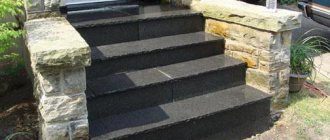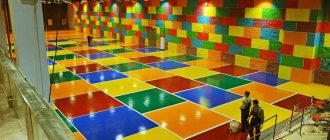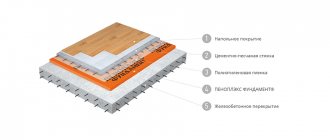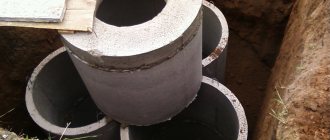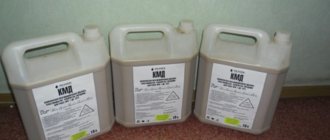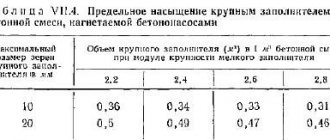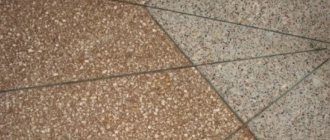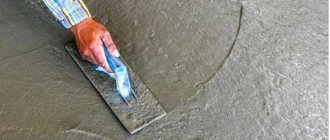How to protect concrete from destruction on the street: coating options for durability
Hello!
Three years ago, the yard was concreted, 100-150 mm thick, without covering anything on top. Now the destruction of concrete has begun. Tell me what can be done, how to save the concrete from destruction, if you are making a screed, what should you add to the solution and what should you cover it with?
Vyacheslav.
Expert answer
Hello, Vyacheslav!
Concrete, although it is one of the most durable and hard building materials, is, unfortunately, very susceptible to the negative influences of the external environment. That is why, when manufacturing concrete products and structures using the industrial method, they are subjected to various methods of strengthening and protection.
All you had to do after arranging the concrete surface on the street was to saturate its surface with a water repellent. The fact is that the lion's share of destruction during the operation of concrete sidewalks, blind areas and garden paths occurs due to moisture penetrating into the micropores of the material. In winter, the liquid freezes and expands, creating many small cracks in the concrete structure. This is what causes peeling, failure, swelling and other defects. The water repellent layer has a water-repellent effect, so the concrete coating lasts much longer with it. It is also important whether the foundation was properly laid out before laying the concrete. The presence of a good drainage cushion under the screed also contributes to its successful and long-term operation in the future. But, as they say, what’s done is done, and therefore all that remains for you is to repair the old paths and take into account your mistakes in the future.
We will not recommend laying paving slabs on the old surface, because for some reason you did not do this in the first place (most likely due to higher financial costs). And, nevertheless, such a reconstruction would be optimal in terms of appearance and durability.
In your case, you can make a repair screed at least 5 cm thick on top of the old concrete coating. This method is often used by home craftsmen, although it is not without its drawbacks. The most important of them is the presence of a so-called cold seam. With this concept, experts designate the plane of contact between dry concrete and fresh mortar. Due to the reduced coefficient of adhesion between the new and old coating, the frost resistance, moisture resistance and strength of concrete decreases.
To reduce the negative impact of a cold seam, before pouring the screed, the surface should be thoroughly cleaned (best with a high-pressure washer) and thoroughly moistened with water. The work is best done in mid-spring or early autumn, at an average daily temperature of at least 15 °C. To prepare the solution, you should use only fresh cement grade PC-500 (in extreme cases, you can also use PC-400), sifted river sand and fine crushed stone in the ratio 1:1.4:2.9 (1:1.1:2 .5 – for PC-400). The amount of water should be such that the solution is not liquid, and moisture appears on the poured surface only after careful compaction. It will be very good if you can find polypropylene or polyvinyl chloride fiber - adding it will create a reinforcement frame in the concrete structure and make it even stronger. Such concrete is guaranteed not to crack during operation.
A screed made from granite screenings (this must be a material obtained by sifting gray rather than white stone) and cement also has good characteristics. This composition is recommended by people with extensive practical experience in concrete work. The materials are mixed in a ratio of 1:3, without adding sand. As in the first case, you should ensure that the solution is not liquid, since excess moisture reduces the strength of concrete when it sets.
Filling the screed correctly is only half the battle. She will be able to meet your expectations only after proper care. To do this, cover the concrete with plastic film and spill its surface with water from a garden watering can 3-4 times a day. Such procedures should be done within the first 6-7 days. Complete setting of concrete occurs after 4 weeks. After this, the surface of the screed is impregnated with a water-repellent agent (it is best to use polymer-based compounds) and covered with film. The method of using protective solutions is described in detail on the packaging, so there is no need to consider this process in detail.
As you can see, the work ahead is serious. And, nevertheless, if you do everything correctly, you will return the old concrete surface to its original attractiveness, and most importantly, make it strong and durable.
pol-master.com
Step by step painting instructions
Before you paint outdoor concrete with your own hands, you need to prepare the surface. This must be done, then the colorful material will stay on the plane for a long time. The preparation is as follows:
- It all starts with cleaning the concrete base from debris, dust, dirt and greasy stains. If there is old putty or paint on the surface, their condition is assessed. If necessary, old layers are removed. Use a chisel or hammer to remove the tiles.
- All identified sinkholes, cracks and potholes are sealed with special repair mixtures. The repaired areas are leveled with a grinding machine or fine-grained sandpaper.
- First, all damaged areas are treated with a primer, and then the entire surface. This improves the adhesion of the coating and concrete and reduces paint consumption. The primer is applied in 1-2 layers, each thoroughly dried.
- A concrete structure without any traces of cracks or pores is ready for painting. The work is carried out based on the recommendations of the paint manufacturer.
The surface after painting should be uniform, without streaks or streaks.
Protection of concrete pavement :: Waterproofing. Materials and technologies:
Question: I am asking for recommendations on protecting the concrete deck of a private house (heat, frost, rain, sun, studded tires, etc.)
Answer: To protect concrete from temperature changes and precipitation, as well as the effects of a chemical reagent (CO2), it is protected using a polymer film. There is a wide range of polymer impregnations on the construction market, and the most affordable of them is ordinary drying oil.
In general, before pouring concrete, you need to think about how to protect it from unwanted influences and so that its surface is uniform and beautiful. This can be done while pouring fresh concrete using the ironing method. After laying fresh concrete, we give it 8-10 hours to partially set and begin ironing its surface. Lightly wet the concrete, sprinkle a layer of clean cement and rub it into the surface of the concrete until a smooth and even surface is obtained. After this procedure, let the concrete harden completely by pouring water on it. We do this with caution to prevent erosion of the concrete. When the concrete has completely set, you can begin to apply a polymer composition to its surface, which forms a protective film. The concrete will be smooth, durable and beautiful.
To protect old concrete surfaces in use, eliminate cracks and voids, I suggest using the non-shrink concrete mixture EMACO 90 and the protective composition MASTERSEAL 588. MASTERSEAL 588 is a waterproofing coating for all grades of concrete; it is an elastic, moisture-resistant waterproofing coating for protecting concrete.
MASTERSEAL 588 is a ready-to-use two-component mixture; after mixing, it is applied to the surface with a sprayer or roller. After polymerization, an elastic, highly elastic membrane is obtained; it is quite resistant to the chemical influences of soft water, waste water, aggressive liquids, and has good frost resistance. Resistant to mechanical wear, excellent barrier to CO2, can be applied to wet surfaces.
Another material available for use in protecting concrete pavements is Birss-Grunt-Concrete. The basis of this material is an aqueous acrylic dispersion, having a high penetrating ability, Birss-Grunt strengthens the surface being treated, protecting it from dirt and moisture. After applying it to concrete, a colorless, elastic protective film is formed that is resistant to mechanical stress. The main purpose of Birss-Grunt-Concrete is to protect concrete from CO2 and the effects of atmospheric cages.
There are special paints for painting concrete surfaces - alkyd, water-based, which are divided into latex, water-based, water-dispersion and others.
Epoxy paints are also used to protect concrete; they have a high degree of adhesion to the concrete surface and excellent adhesion. Concrete bases coated with such paints have good resistance to mechanical stress.
blogstroiki.ru
Main types
Today, manufacturers offer a wide range of paints for outdoor concrete surfaces. They all have different characteristics, differ in manufacturing technology and the base used. Therefore, before you start painting, you should decide what type you need.
Acrylic is the most popular when carrying out finishing work. It contains polyacrylates and their copolymers. It is characterized by:
- environmental cleanliness and safety;
- good adhesion to the concrete surface;
- quick drying;
- high wear resistance;
- economical consumption;
- ease of care of the painted surface;
- wide range of colors;
- long service life.
The main disadvantage is the rather high price of such a composition.
Oil - belongs to the category of economical building materials that are widely used by users. The composition includes alkyd resins, synthetic and combined drying oils. The advantages of the coating include:
- strength and wear resistance;
- good adhesion;
- easy care;
- the painted surface is resistant to moisture.
Water-based paints are made from a water base, suspension and binding components. The ratio of these components differs depending on the required characteristics. For this coating, it is important to comply with storage conditions. Its main advantage is environmental safety. In addition, there are the following advantages:
- has no odorous volatile substances;
- is able to retain the applied layer of paint for a long time after drying;
- has a wide range of colors and shades;
- prevents the development of mold and bacteria.
You should not work with this coating in rainy weather. And before using it you need to mix it well.
Polymer - gives concrete, in addition to protective properties, good decorative qualities. It is created on the basis of acrylic, polyurethane or epoxy. The paint is used in sales areas and industrial premises. The polymer coating is different:
- low cost;
- wide range of colors;
- high resistance to chemical reagents;
- the surface after coating is suitable for use within three days;
- ability to use at extremely low temperatures.
A negative feature of this material is the limitation in the methods of application to concrete structures.
Water-epoxy - is a composition consisting of two water-based components. When hardened, the coating creates a film on the surface that protects from external influences, hides defects and imparts decorative qualities. The raw material retains its original color for a long time. Water-based epoxy paint has:
- resistance to chemical compounds;
- does not have a sharp, unpleasant and difficult to ventilate odor;
- increased adhesion to the concrete surface;
- especially decorative depending on the application technique.
Rubber - this coating appeared relatively recently. As a result of its drying, a flexible polymer film is formed. As the air temperature decreases, it contracts, and as the air temperature increases, it expands. This protects the material from chipping and cracking. The paint base is a water-dispersion solution with acrylate polymer. Unique performance characteristics include:
- ease of application;
- resistance to temperature changes;
- ability to perform waterproofing functions;
- ability to withstand exposure to ultraviolet rays.
It is important to apply rubber paint to the surface correctly. If painting is done incorrectly, the film may peel off.
Protecting concrete from destruction on the street
How strong and durable concrete structures will be can be influenced by the quality and degree of waterproofing before construction begins. Only well-selected waterproofing systems can prevent substances from entering the structure of the material that will have a destructive effect. They extend the life of a concrete structure and reduce restoration and maintenance costs.
Need for protection
Protection of concrete from destruction on the street is necessary for the reason that the described material, although very durable, is constantly exposed to destructive factors during operation, including precipitation, chemical reagents, and industrial gases.
Sometimes concrete is constantly in contact with water; in this case, materials that provide high waterproofing and resistance to chemical and abrasive loads are used to protect it. In this case, we are talking about concrete tanks, in which the depth of corrosion damage can reach 50 cm. If the material is not protected, then over time it can simply turn into dust.
Types of materials for protection
To protect concrete outdoors, materials are used that prevent exposure to moisture, corrosion, and also increase strength. This is possible with water-repellent substances that are applied by impregnation. This makes it possible to reduce the contact angle, because the concrete is protected by a silicon-containing composition. The advantage of this approach is durability and water resistance, as well as strength. Such substances are represented by enamels, which, under the influence of alkalis, become soluble and lose their hydrophobic properties.
Concrete can be protected from destruction by waterproof film. A layer of various resins, for example, polyvinyl chloride or polyurethane, is formed on the surface. The disadvantage of this method is low vapor permeability.
If the coating is exposed to steam for a long time, it will delaminate and collapse. In order to eliminate these disadvantages, a protective layer and impregnation should be combined, but the composition must be created on the same basis. It is important to use an alkali-resistant film, while the protective layer must have increased vapor permeability.
Protection against destruction
When considering means for protecting concrete, you must highlight methods that would prevent the destruction of the material. Such means of protection include antifungal and antiseptic, as well as paints and varnishes and impregnations. The structure can be protected from destruction by applying an anti-corrosion coating, insulation and impregnation.
Corrosion protection
The development of corrosion occurs due to the porosity of concrete. This suggests that it is important to limit the structure from contact with moisture and eliminate the effects of precipitation. If this cannot be avoided, then concrete should be made with increased density so that the structure is devoid of pores.
Sometimes a protective coating with water-repellent characteristics is applied to the material. Protecting concrete from water using hydrophobization is the best option for preventing corrosion. The material will repel water and maintain the porosity of the structure, and the structure can be operated at a wide range of temperatures ranging from -40 to +50 °C.
Hydrophobization for anti-corrosion protection is carried out in several stages. Additives are introduced into cement to increase density and regulate porosity. At the next stage, antifungal materials are used as impregnations to seal the structure. To prevent exposure to moisture, paints and varnishes are used. To prevent corrosion, carbon fiber tapes should be used. They are great for those areas where the metal component of the structure is rusty.
Moisture protection
Concrete protection was previously carried out using dry cement mixtures, synthetic sheets and spacers, and roofing felt. This is not enough for complete protection against water. To solve the problem, the concrete surface must be treated with a liquid with water-repellent properties. The coating will fill cracks and pores, provide durability and reliable protection.
Protection of concrete from moisture is carried out according to a certain algorithm. At the first stage, the finished dry layer must be protected with a sheet of roofing felt or waterproof building material. Using bitumen emulsion, the seams between the sheets are processed. A water-repellent coating, paint or varnish is applied on top.
Using an anchor sheet
To protect concrete today, a polymer sheet is increasingly used, which is located on the surface in a checkerboard pattern. It is made from high-density polyethylene, abbreviated HDPE. Concrete protection sheet is used for monolithic and prefabricated reinforced concrete structures. Its fastening has a large number of fixation points, which ensures reliable connection or adhesion to concrete or mortar.
The shape of the anchors is formed by extrusion during production, which guarantees high fastening strength. Even with strong fluctuations in temperature and pressure, optimal stress distribution ensures that the structure of the material is preserved, because the impact force can be caused by groundwater. Anchor sheet for concrete protection solves many problems. It creates a barrier against damage to the material by abrasive particles and chemicals.
The layer acts as an infiltrate, eliminates corrosion of concrete and protects the material from mechanical damage that can be caused by humidity, soil vibration, and the influence of plant roots. The anchor sheet can be installed on the surface during new construction or for the rehabilitation of existing structures. Reconstruction of finished structures eliminates corrosive wear and restores lost load-bearing capacity. The polymer sheet compensates for abrasive wear and prevents further destruction.
Installation of anchor sheet
If you plan to protect concrete with an anchor sheet, then you need to familiarize yourself with the features of its installation. At the first stage, the material is cut to the size and shape of the surface to be protected. The canvas is attached with an indentation from the edge on removable formwork or by induction welding using mounting discs.
A concrete mixture is poured into the space between the polymer sheet and the protected surface, which makes it possible to monolith the anchor fastenings. Using extrusion welding, the joints between the anchor sheets are welded. The resulting seam has 97% of the strength of the base material and helps create an airtight shell.
Use of VVM-M composition
If you are thinking about the question of how to coat concrete outdoors for protection, then as an example you can consider the composition of the VVM-M brand. The substance is applied by air spray, and brushes and rollers are used to impregnate the surface. The thickness of the coating and the depth of impregnation are adjusted by the distance of the sprayer from the surface to be treated.
When choosing a spray gun, you should prefer a device that can produce 2 atm. It is necessary to move 30-50 cm away from the concrete base. The recommended coating thickness reaches 100 microns. If you plan to impregnate concrete, then the thickness of the applied layer is 3 cm. Before forming each subsequent layer, you do not need to wait for the previous one to dry. The materials described are made from domestic polymers, and are inexpensive, because they are based on non-scarce raw materials.
Foundation protection
If you are faced with the need to protect the concrete at the base of the house’s foundation, then you can use coating the side surfaces with waste machine oil and plastic film. The base can be protected by a layer of soil laid around the perimeter. Additionally, you can use polystyrene foam, expanded clay or slag. This allows you to reduce the depth of soil freezing and eliminate or reduce the impact of negative factors on concrete.
Comprehensive protection against aggressive influences and moisture
In order to achieve the best effect, you can resort to using several technologies. For this purpose, primary protection is used, in which mixing of the cement mortar is accompanied by the addition of chemical modifiers and additives.
Sulfates should be used to block cracks; they help prevent corrosion and provide strength and durability. Secondary protection consists of applying mastics, impregnations, solutions and biocides. An additional measure will be protective finishing, which involves applying plaster, installing a layer of thermal insulation and installing suspended ventilated facades.
Finally
Concrete is a very strong material that is famous for its durability, but it has many pores through which moisture inevitably penetrates. When it freezes and crystallizes, it begins to increase in volume, which negatively affects the integrity of the material. But such an impact is not the only one that can destroy concrete.
To prevent dusting and further loss of strength, it is necessary to protect the structure by adding special substances to the solution that reduce porosity. During the operation stage, the surface can be protected with mastics and impregnations, which create a kind of barrier to moisture.
What does the shape of your nose say about your personality? Many experts believe that just by looking at your nose you can tell a lot about a person's personality. Therefore, when you first meet, pay attention to the nose of a stranger... Psychology 11 strange signs that indicate that you are good in bed Do you also want to believe that you give your romantic partner pleasure in bed? At least you don't want to blush and apologize... Sexuality What happens to the body of a person who does not have sex? Sex is almost the same basic need as eating. At least once you start doing it, you won’t stop. Even if you adhere to... Sexuality Terrifyingly beautiful: 15 shocking plastic surgeries that ended disastrously Plastic surgery among the stars remains incredibly popular to this day. But the problem is that in the past the result was not always perfect... Plastic surgery 14 ways cats show you their love There is no doubt that cats love us as much as we love them. Unless you are one of those people who views this kind of thing favorably... Pets Never do this in church! If you are not sure whether you are behaving correctly in church or not, then you are probably not doing the right thing. Here is a list of terrible... Christianity
twofb.ru
Criterias of choice
To seal defective areas, special mixtures are produced or cement mortar is used. When choosing a repair composition for the floor, the operating conditions of the coating are taken into account. There are many factors:
- weather;
- exposure to chemicals;
- temperature regime;
- load intensity.
Attention! Repair compounds from domestic manufacturers are considered the best choice, because they are specially designed for weather conditions in our country.
We suggest you read HOW TO TIE SHOES ON SNEAKERS
When choosing, they focus on quality. If the mixture has a high cost, it should have the following properties:
- fast setting;
- high degree of adhesion;
- thixotropy (increase in viscosity).
If the composition is of high quality, then the composition contains polymer fiber or filler from small fractions. This solution structure allows you to make a layer up to 10 cm, reducing consumption to 10%. They are strongly reinforced throughout the structure and do not peel off.
Concrete protection
The combination of materials from the HardSIL and SurfSIL line allows you to achieve the maximum long-term effect of protecting concrete from corrosion and environmental influences.
Examples of using LITSIL® compounds to protect outdoor concrete floors:
|
|
The result of treating an external concrete area with LITSIL® compounds (summer season)
The result of treating an external concrete area with LITSIL® compounds (winter season)
litsil.ru
Important nuances
When constructing concrete paths on the street, additional treatment with a water repellent is mandatory. This work is carried out directly on the construction site. The main reasons for the destruction of concrete structures on the street can be exposure to precipitation, moisture or low temperatures.
As you can see from the article, processing concrete on the street is not a very labor-intensive job. The main thing is to choose the right solutions with hydrophobic properties. Experts recommend paying attention only to formulations with quality certificates. The processing process itself is simple; even a beginner in the construction craft can handle the work. You just need to follow the instructions on the packaging.
Restoration of a concrete platform for a car
The Tajiks made a concrete screed under the car. The concrete all melted away along with the sand. It’s been crumbling for 2.5 years, what can I do now? The budget doesn't really allow for remodeling. How can I fix it on a budget?
Larisa, Shcherbinka.
Hello, Larisa from Shcherbinka!
/At the word Shcherbinka, I always remember how your scientists from the Institute of Railway Transport placed an electric motor with a power of several hundred kilowatts and weighing about a ton for five people in two part-time working days in the supply chamber. And they planned almost half a month of work for this, dismantling the roof, hiring a crane, restoring the brickwork, etc. costing tens, if not a hundred times more than what we were paid. Here it is, the difference between theory and savvy ingenuity! However, this is an irrelevant remark./
How to cheaply fix the Tajik problem? It would be a good idea to look first, otherwise I would advise you not to look, and after another 2.5 years everything will fall apart again. And you will remember me with a “quiet, kind word.”
Therefore, I will tell you how to do it correctly, and you can think further.
To install a parking lot, otherwise a platform for a passenger car, a layout is first made. That is, they level the surface of the soil. Remove the root system of weeds, if any. Pour a layer of sand about 10 centimeters thick. Level it and pour it with water to compact it. Then they take ready-made concrete or prepare it themselves.
Why use sand, or SGS (sand and gravel mixture), cement grade M300 - M400. With a proportion of approximately 200 kg of cement, 800 kg of sand, a little more than a ton of crushed stone. All this is filled with 200 liters of water. The result will be concrete of approximately M100 grade, the same one that is used for your type of concrete screeds.
The screed is made about 10 centimeters thick. For strength, a welded metal mesh is placed in it. Which should be located in the middle of the thickness of the screed.
We invite you to familiarize yourself with Tomato Slavic characteristics and description of the variety
A slope is made from the middle of the screed in all directions, or from the center of the site, sometimes in one direction, so that the water drains and does not tear the concrete when it turns into ice.
I won’t go into more detail, but if you search on my website, I’ve already answered this question several times more broadly.
Most likely your coven did something wrong. They definitely didn’t spare the sand, which can’t be said about the cement.
What to do? If you don’t radically redo it (and this is sometimes necessary, I can’t say for sure without looking), then thoroughly sweep the entire area and moisten it with water. Lay the welded mesh in cells from 5/5 to 10/10 centimeters, your choice. The grid is sold in cards two meters long and half a meter wide. Although this is not important. The cards overlap each other about five centimeters. The goal is to cover the entire parking area.
Then prepare the concrete according to the specified proportions. Or bring a purchased one by dump truck (mixer), but it will be somewhat more expensive. Fill the area with a layer of at least 5 centimeters. That is, returning once again to the required volume, for example, with a site of 5 * 2 meters and a thickness of 5 centimeters, you will need about half a cubic meter of concrete. Or a little more. This is completely approximate, because the ratio of the weight and volume of concrete is not calculated according to a proportional scheme.
I'll omit the details. After the screed hardens, and this, depending on the weather, which is preferably about plus 10 - plus 20 degrees Celsius, can last about four days to a week, the screed is able to withstand the weight of a passenger car. Although concrete reaches full strength only after 28 days.
It shouldn't rain. Otherwise the sand will be washed away. In hot sunny weather, it is recommended to spill the concrete with water to prevent it from becoming covered with microcracks. It is optimal to completely cover the concrete with a tarpaulin and pour water over it. If it evaporates under the sun's rays, water it again. And so all four or seven days in a row.
I could be wrong, but this pleasure can cost from 5 to 10 thousand rubles. Depending on many factors, ranging from the cost of materials, transportation costs, your own or hired labor and other related factors. The price is quite reasonable. Although shabashniki can charge twice as much.
